Mechanical, Thermal and Rheological Properties of Polyethylene-Based Composites Filled with Micrometric Aluminum Powder
Abstract
:1. Introduction
2. Materials and Methods
2.1. Materials
2.2. Preparation of Polymer Composites
2.3. Measurements
3. Results and Discussion
3.1. Spectroscopic Analysis
3.2. Physical Properties
3.3. Mechanical Properties
3.4. Rheological Behavior
3.5. Thermal Properties
3.6. Crystalline Structure
4. Conclusions
Author Contributions
Funding
Conflicts of Interest
References
- Bakis, C.E.; Bank, L.C.; Brown, V.L.; Cosenza, E.; Davalos, J.F.; Lesko, J.J.; Machida, A.; Rizkalla, H.; Triantafillou, T.C. Fiber-Reinforced Polymer Composites for Construction—State-of-the-Art Review. J. Compos. Constr. 2002, 6, 73–87. [Google Scholar] [CrossRef] [Green Version]
- Chamis, C.C. Polymer Composite Mechanics Review—1965 to 2006. J. Reinf. Plast. Compos. 2007, 26, 987–1019. [Google Scholar] [CrossRef]
- Dixit, S.; Goel, R.; Dubey, A.; Shivhare, P.R.; Bhalavi, T. Natural Fibre Reinforced Polymer Composite Materials—A Review. Polym. Renew. Resour. 2017, 8, 71–78. [Google Scholar] [CrossRef]
- Mohd Radzuan, N.A.; Sulong, A.B.; Sahari, J. A review of electrical conductivity models for conductive polymer composite. Int. J. Hydrog. Energy 2017, 42, 9262–9273. [Google Scholar] [CrossRef]
- Chapple, S.; Anandjiwala, R. Flammability of Natural Fiber-reinforced Composites and Strategies for Fire Retardancy: A Review. J. Thermoplast. Compos. 2010, 23, 871–893. [Google Scholar] [CrossRef]
- Thakur, V.K.; Kessler, M.R. Self-healing polymer nanocomposite materials: A review. Polymer 2015, 69, 369–383. [Google Scholar] [CrossRef] [Green Version]
- Rudawska, A.; Jakubowska, P.; Kloziński, A. Surface free energy of composite materials with high calcium carbonate filler content. Polimery 2017, 62, 434–440. [Google Scholar] [CrossRef]
- Zhang, J.; Wu, J.-L.; Mo, H.; Ma, Z.-M.; Zhou, N.; Yuan, J.; Shen, J. Rheology and processability of polyamide66 filled with different-sized and size-distributed calcium carbonate. Polym. Compos. 2011, 32, 1633–1639. [Google Scholar] [CrossRef]
- Kloziński, A.; Jakubowska, P.; Przybylska, J.E.; Przekop, R. Application of in-line rheological measurements for characterization of polypropylene/opoka rock powder composites. Polimery 2019, 64, 282–289. [Google Scholar] [CrossRef] [Green Version]
- Stabik, J. Selected Problems of Rheology of Plasticized Filled Polymers; Publisher of the Silesian University of Technology: Gliwice, Poland, 2004. [Google Scholar]
- Mosavian, M.T.H.; Bakhtiari, A.; Sahebian, S. Influence of Alumina Particles on Thermal Behavior of High Density Polyethylene (HDPE). Polym. Plast. Technol. Eng. 2012, 51, 214–219. [Google Scholar] [CrossRef]
- Xu, Y.; Chung, D.D.; Mroz, C. Thermally conducting aluminum nitride polymer-matrix composites. Compos. Part A Appl. S 2001, 32, 1749–1757. [Google Scholar] [CrossRef]
- Huang, X.; Kim, C.; Ma, Z.; Jiang, P.; Yin, Y.; Li, Z. Correlation between rheological, electrical, and microstructure characteristics in polyethylene/aluminum nanocomposites. J. Polym. Sci. B Polym. Phys. 2008, 46, 2143–2154. [Google Scholar] [CrossRef]
- Zhou, W. Thermal and dielectric properties of the AlN particles reinforced linear low-density polyethylene composites. Thermochim. Acta 2011, 512, 183–188. [Google Scholar] [CrossRef]
- Bigg, D.M. Mechanical, thermal, and electrical properties of metal fiber-filled polymer composites. Polym. Eng. Sci. 1979, 19, 1188–1192. [Google Scholar] [CrossRef]
- Tavman, I.H. Thermal and mechanical properties of aluminum powder-filled high-density polyethylene composites. J. Appl. Polym. Sci. 1996, 62, 2161–2167. [Google Scholar] [CrossRef]
- Pinto, G.; Jiménez-Martín, A. Conducting aluminum-filled nylon 6 composites. Polym. Compos. 2001, 22, 65–70. [Google Scholar] [CrossRef]
- Boudenne, A.; Ibos, L.; Fois, M.; Gehin, E.; Majeste, J.-C. Thermophysical properties of polypropylene/aluminum composites. J. Polym. Sci. B Polym. Phys. 2004, 42, 722–732. [Google Scholar] [CrossRef]
- Kodjie, S.L.; Li, L.; Li, B.; Cai, W.; Li, C.Y.; Keating, M. Morphology and crystallization behavior of HDPE/CNT nanocomposite. J. Macromol. Sci. Phys. 2006, 45, 231–245. [Google Scholar] [CrossRef]
- Gulmine, J.; Janissek, P.; Heise, H.; Akcelrud, L. Polyethylene characterization by FTIR. Polym. Test. 2002, 21, 557–563. [Google Scholar] [CrossRef]
- Guadagno, L.; Naddeo, C.; Vittoria, V.; Camino, G.; Cagnani, C. Chemical and morphologial modifications of irradiated linear low density polyethylene (LLDPE). Polym. Degrad. Stabil. 2001, 72, 175–186. [Google Scholar] [CrossRef]
- Almeida, G.; Rémond, R.; Perré, P. Hygroscopic behaviour of lignocellulosic materials: Dataset at oscillating relative humidity variations. J. Build. Eng. 2018, 19, 320–333. [Google Scholar] [CrossRef]
- Fernlund, G.; Wells, J.; Fahrang, L.; Kay, J.; Poursartip, A. Causes and remedies for porosity in composite manufacturing. In IOP Conference Series: Materials Science and Engineering; IOP Publishing: Bristol, UK, 2016; Volume 139, p. 012002. [Google Scholar] [CrossRef] [Green Version]
- Vaxman, A.; Narkis, M.; Siegmann, A.; Kenig, S. Void formation in short-fiber thermoplastic composites. Polym. Compos. 1989, 10, 449–453. [Google Scholar] [CrossRef]
- Kubát, J.; Rigdahl, M.; Welander, M. Characterization of interfacial interactions in high density polyethylene filled with glass spheres using dynamic-mechanical analysis. J. Appl. Polym. Sci. 1990, 39, 1527–1539. [Google Scholar] [CrossRef]
- Rojas, J.; Crespo, D. Onset Frequency of Fatigue Effects in Pure Aluminum and 7075 (AlZnMg) and 2024 (AlCuMg) Alloys. Metals 2016, 6, 50. [Google Scholar] [CrossRef] [Green Version]
- Correa, C.A.; Razzino, C.A.; Hage, E. Role of maleated coupling agents on the interface adhesion of polypropylene-wood composites. J. Thermoplast. Compos. 2007, 20, 323–338. [Google Scholar] [CrossRef]
- Moonchai, S.; Moonchai, D. Modelling and optimization of rebound resilience and hardness of defatted rice bran/calcium carbonate-filled NR vulcanisates. Polym. Test. 2013, 32, 1472–1478. [Google Scholar] [CrossRef]
- Jamil, M.S.; Ahmad, I.; Abdullah, I. Effects of Rice Husk Filler on the Mechanical and Thermal Properties of Liquid Natural Rubber Compatibilized High-Density Polyethylene/Natural Rubber Blends. J. Polym. Res. 2006, 13, 315–321. [Google Scholar] [CrossRef]
- Kawasaki, M.; Alhajeri, S.N.; Xu, C.; Langdon, T.G. The development of hardness homogeneity in pure aluminum and aluminum alloy disks processed by high-pressure torsion. Mater. Sci. Eng. A 2011, 529, 345–351. [Google Scholar] [CrossRef]
- Brostow, W.; Hagg Lobland, H.E.; Narkis, M. Sliding wear, viscoelasticity, and brittleness of polymers. J. Mater. Res. 2006, 21, 2422–2428. [Google Scholar] [CrossRef] [Green Version]
- Hato, M.J.; Ray, S.S.; Luyt, A.S. Melt-State Viscoelastic Properties of POSS-Containing Polyethylene Nanocomposites. Adv. Sci. Lett. 2011, 4, 3585–3589. [Google Scholar] [CrossRef]
- Li, J.; Zhou, C.; Wang, G.; Zhao, D. Study on rheological behavior of polypropylene/clay nanocomposites. J. Appl. Polym. Sci. 2003, 89, 3609–3617. [Google Scholar] [CrossRef]
- Sahraeian, R.; Esfandeh, M.; Hashemi, S.A. Rheological, Thermal and Dynamic Mechanical Studies of the Ldpe/Perlite Nanocomposites. Polym. Compos. 2013, 21, 243–250. [Google Scholar] [CrossRef]
- Zhou, Z.; Zhang, Y.; Zhang, Y.; Yin, N. Rheological behavior of polypropylene/octavinyl polyhedral oligomeric silsesquioxane composites. J. Polym. Sci. Part B Polym. Phys. 2008, 46, 526–533. [Google Scholar] [CrossRef]
- Cho, K.; Lee, B.H.; Hwang, K.M.; Lee, H.; Choe, S. Rheological and mechanical properties in polyethylene blends. Polym. Eng. Sci. 1998, 38, 1969–1975. [Google Scholar] [CrossRef]
- Roy, S.; Scionti, V.; Jana, S.C.; Wesdemiotis, C.; Pischera, A.M.; Espe, M.P. Sorbitol–POSS Interactions on Development of Isotactic Polypropylene Composites. Macromolecules 2011, 44, 8064–8079. [Google Scholar] [CrossRef]
- Vleeshouwers, S.; Meijer, H.E.H. A rheological study of shear induced crystallization. Rheol. Acta 1996, 35, 391–399. [Google Scholar] [CrossRef] [Green Version]
- Fan, Y.; Lin, Y.; Ruan, M. Effect of substrates on crystallization of high density polyethylene. J. Cent. South. Univ. Technol. 2008, 15, 67–71. [Google Scholar] [CrossRef]
- Arina, M.; Honkanen, A.; Tammela, V. Mineral fillers in low density-polyethylene films. Polym. Eng. Sci. 1979, 19, 30–39. [Google Scholar] [CrossRef]
- Zhou, W. Thermal and Dielectric Properties of the Aluminum Particle Reinforced Linear Low-Density Polyethylene Composites. Polym. Eng. Sci. 2011, 51, 917–924. [Google Scholar] [CrossRef]
- Di Lorenzo, M.L.; Silvestre, C. Non-isothermal crystallization of polymers. Prog. Polym. Sci. 1999, 24, 917–950. [Google Scholar] [CrossRef]
- Low, A.; Vesely, D.; Allan, P.; Bevis, M. An investigation of the microstructure and mechanical properties of high density polyethylene spherulites. J. Mater. Sci. 1978, 13, 711–721. [Google Scholar] [CrossRef]
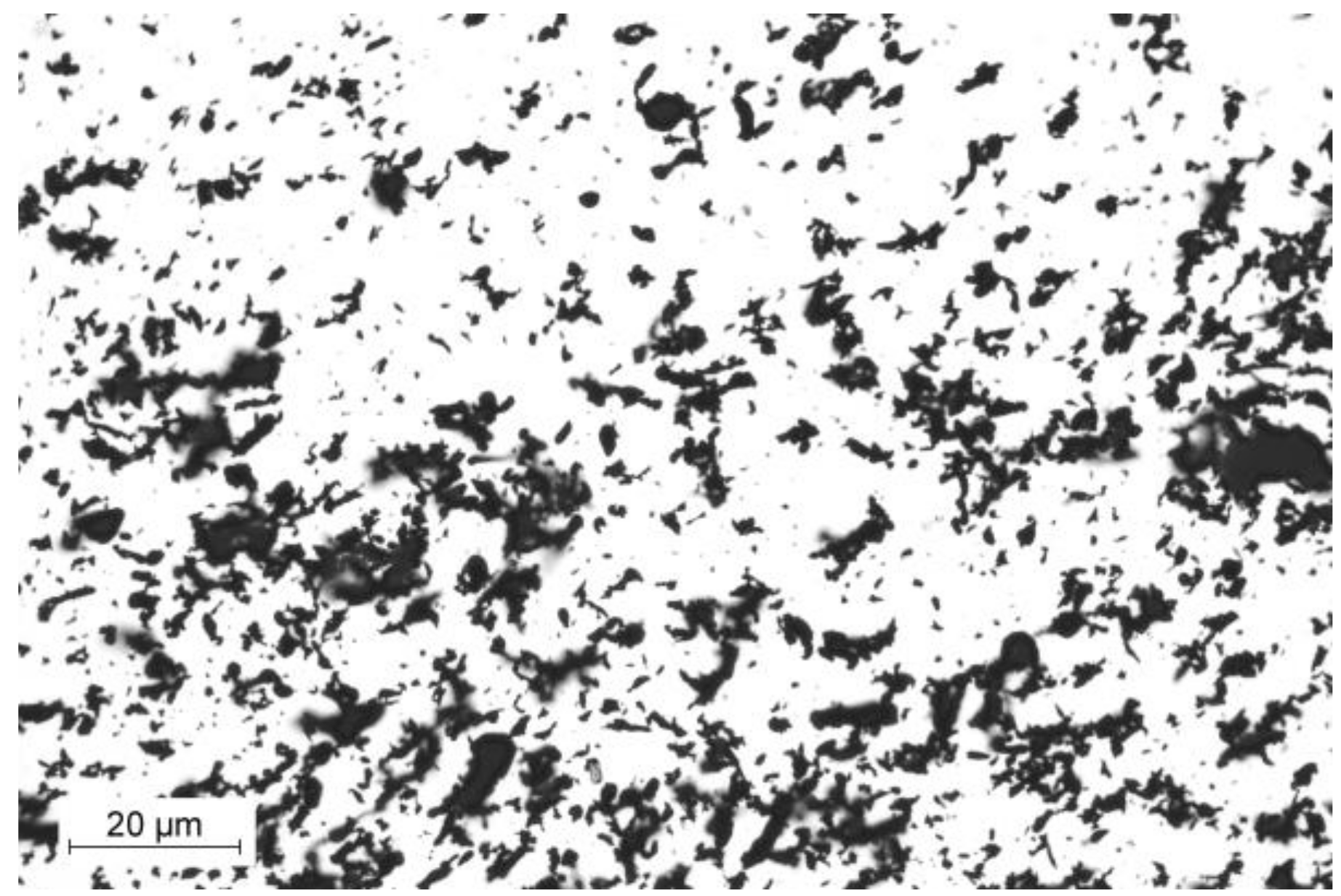
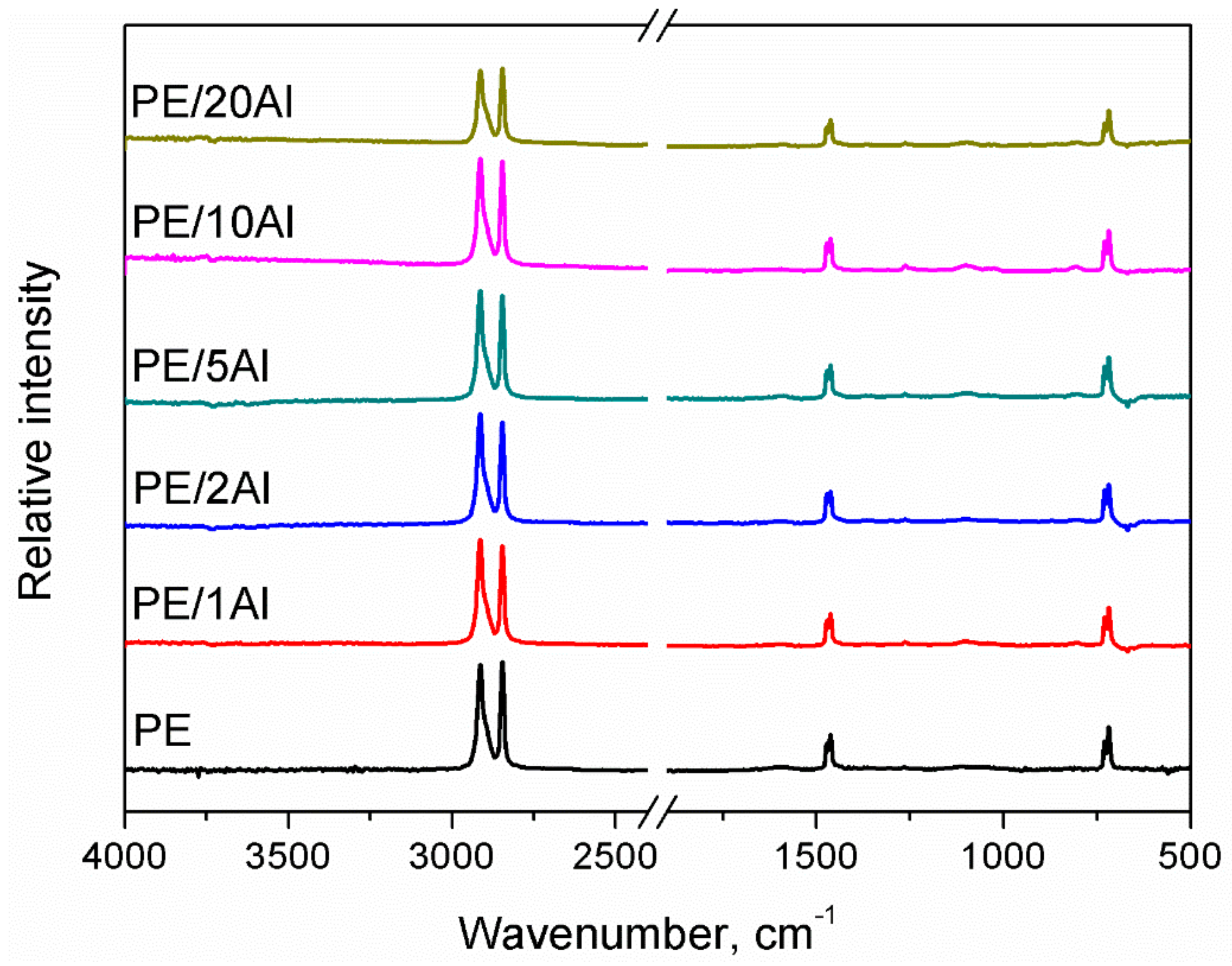



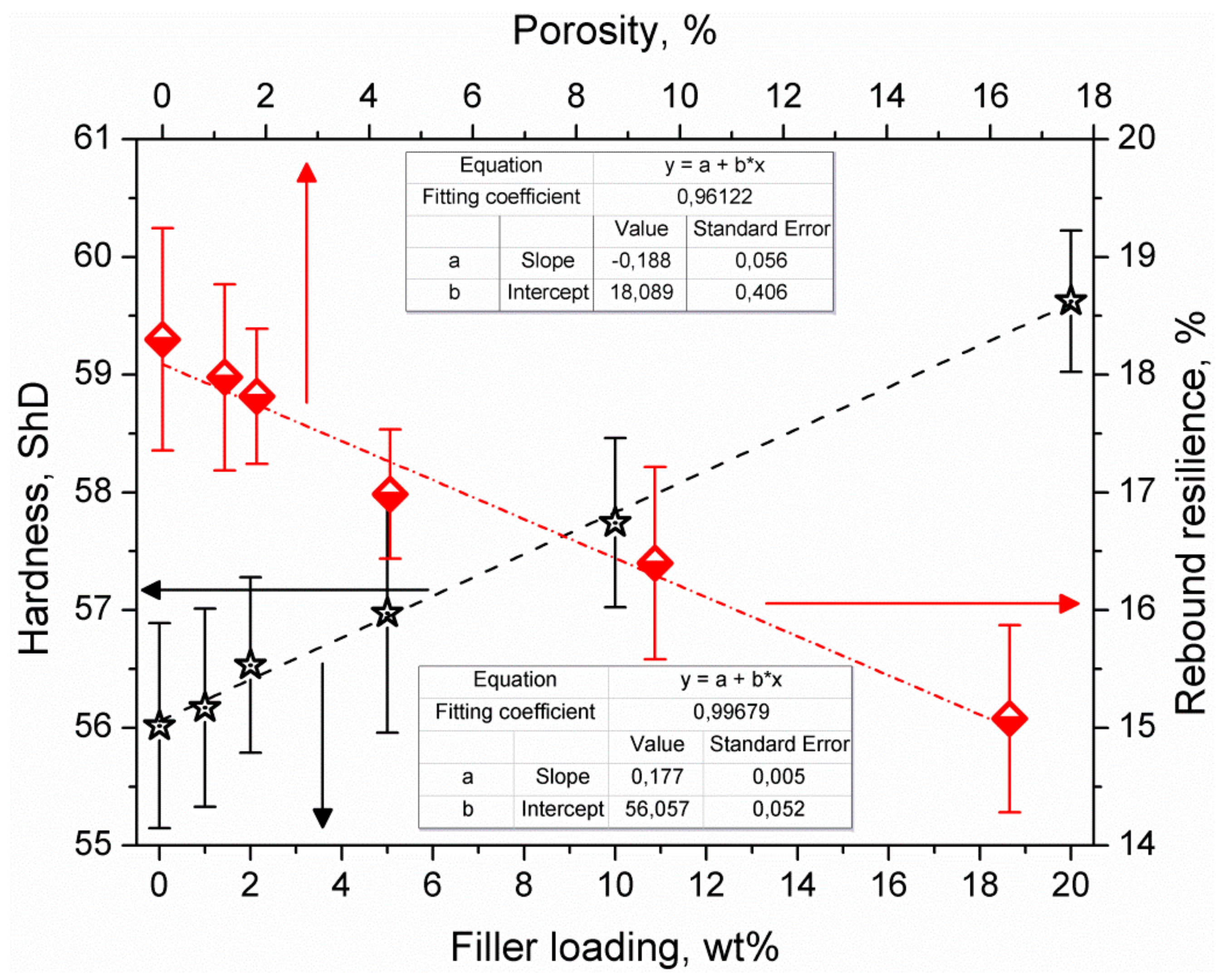

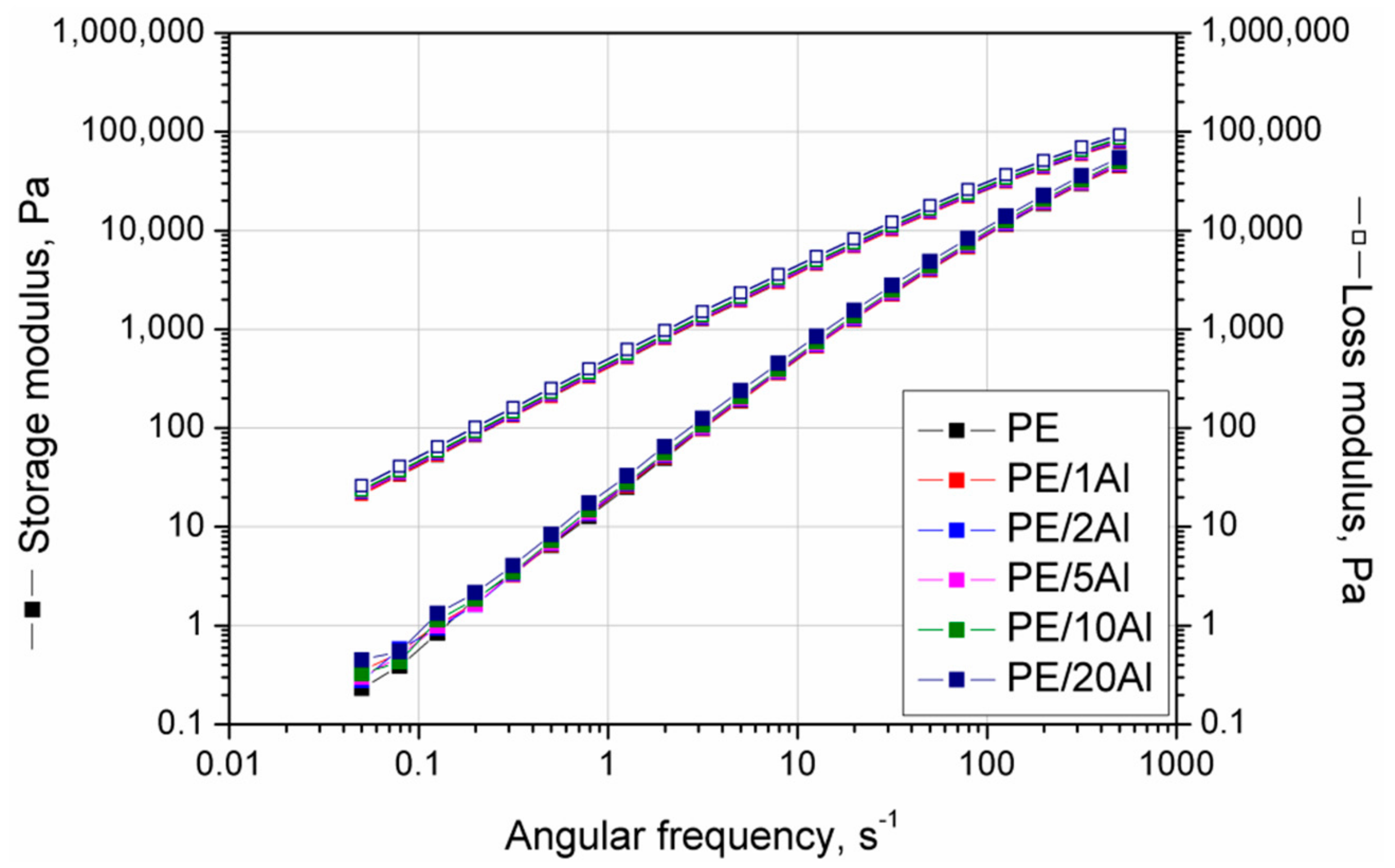
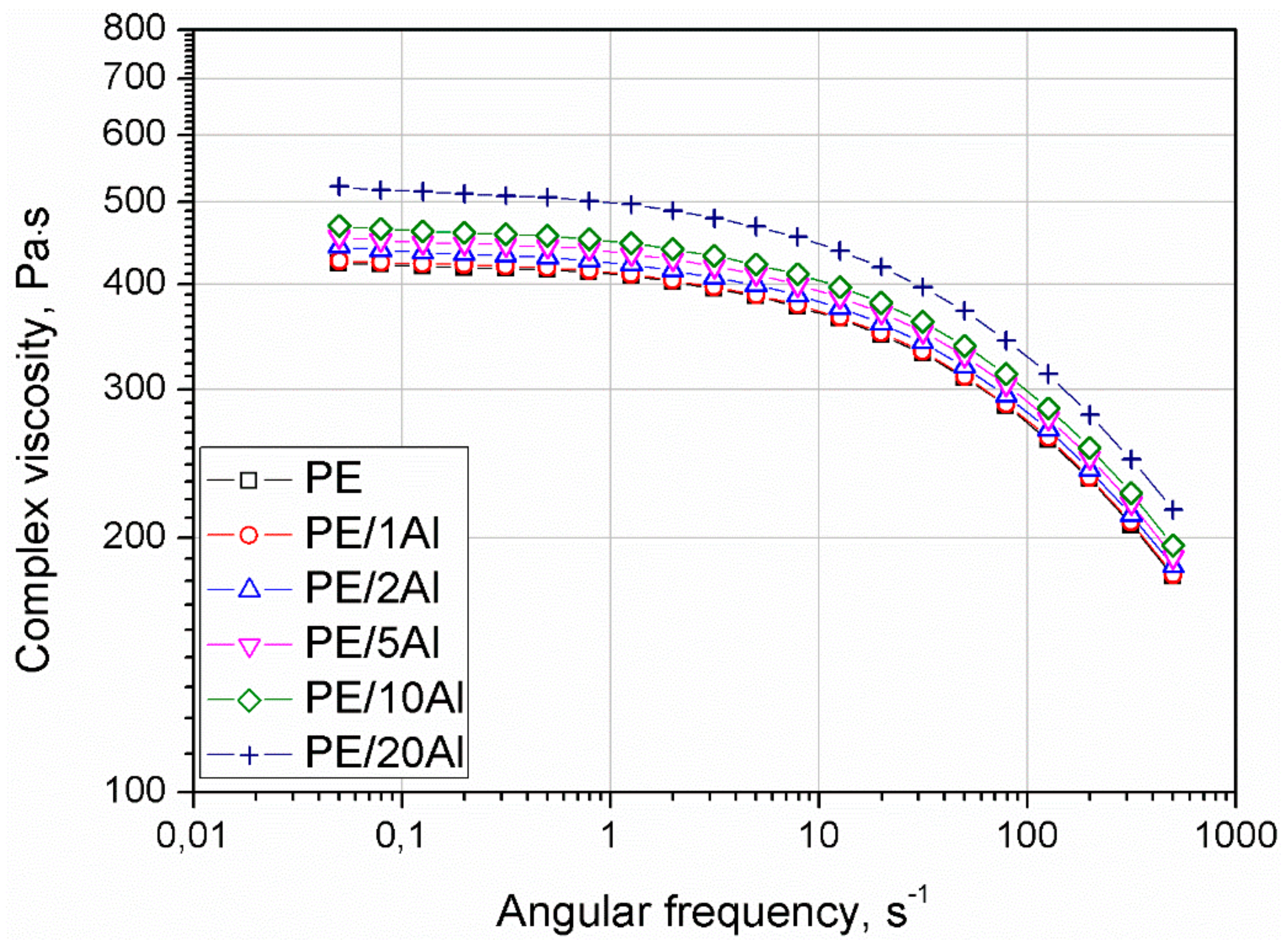
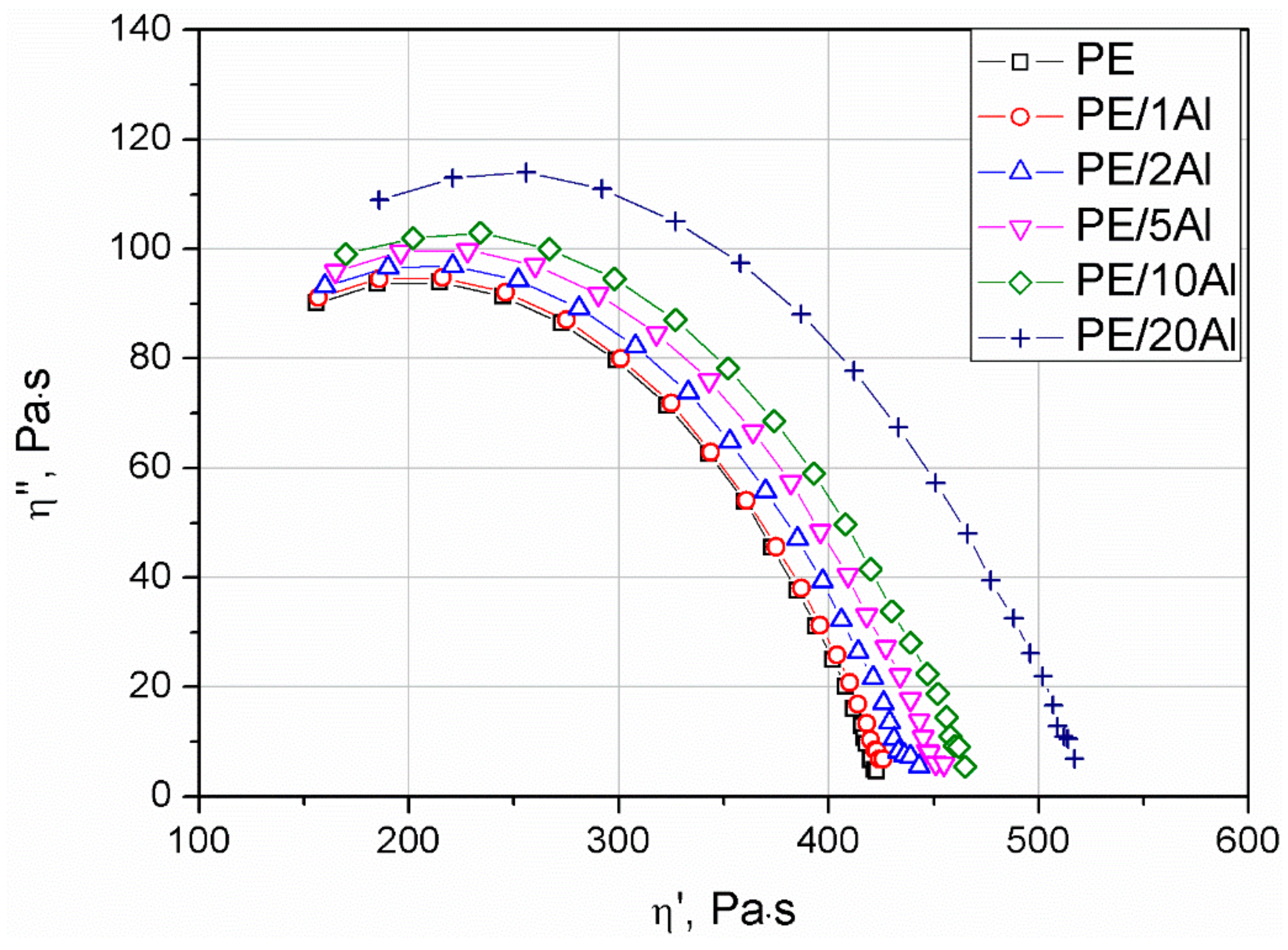

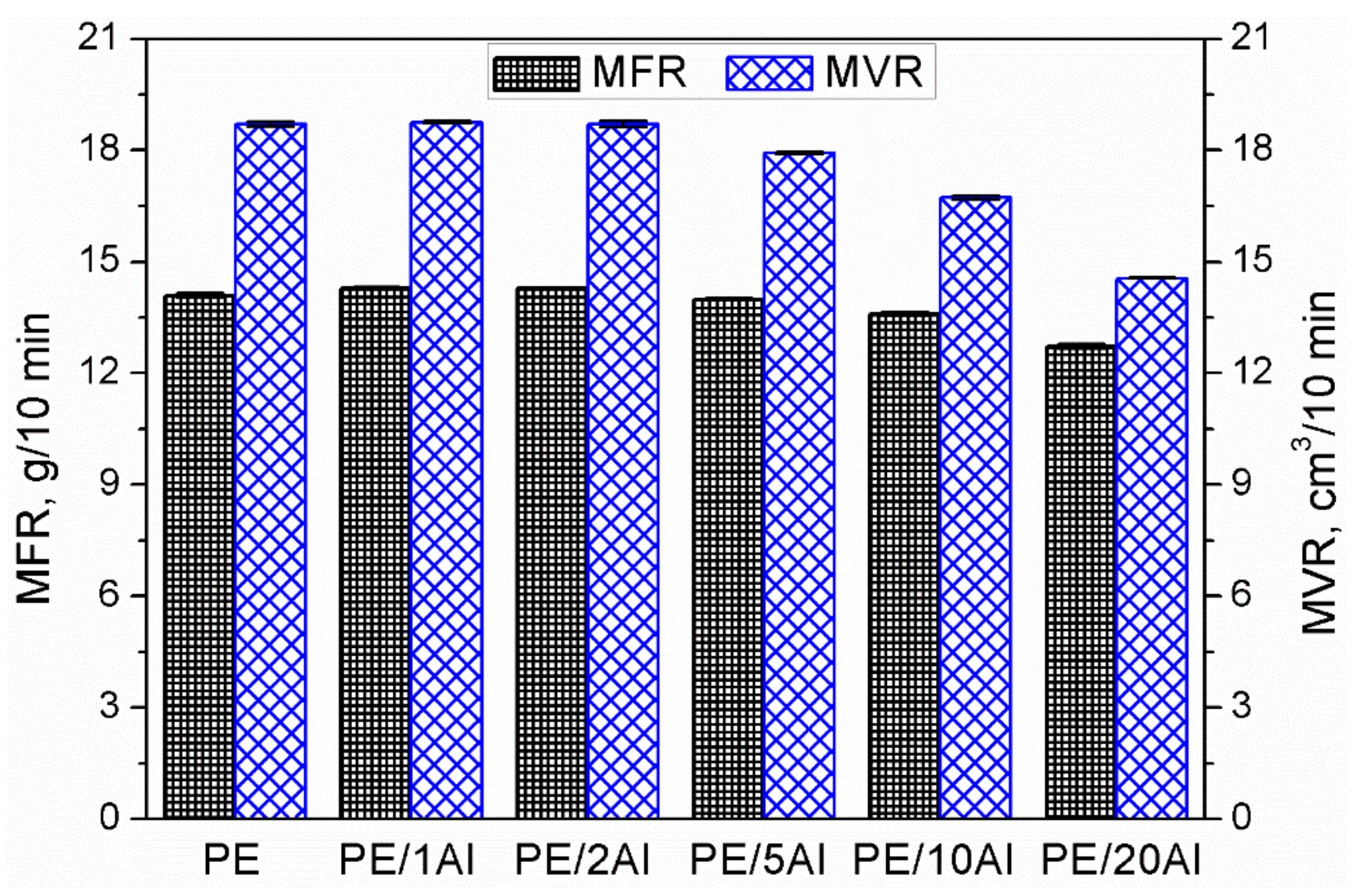

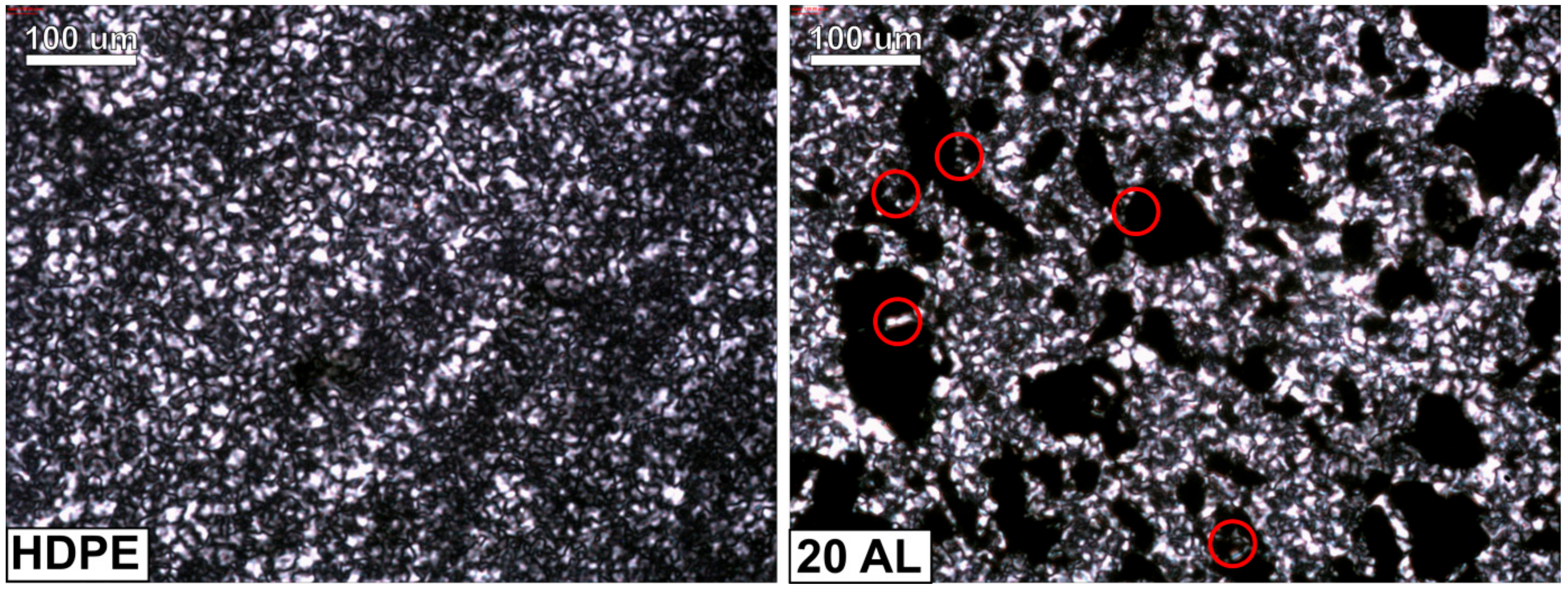
| Property | PE | PE/1Al | PE/2Al | PE/5Al | PE/10Al | PE/20Al |
|---|---|---|---|---|---|---|
| Porosity, % | 0.00 | 1.20 | 1.83 | 4.40 | 9.52 | 16.37 |
| Adhesion factor | — | −0.0436 | −0.0580 | −0.0404 | −0.0359 | 0.0352 |
| Tensile strength, MPa | 24.2 ± 0.9 | 24.8 ± 0.6 | 25.2 ± 1.2 | 24.2 ± 0.7 | 23.6 ± 0.8 | 21.3 ± 0.6 |
| Elongation at break, % | 50.0 ± 14.9 | 25.6 ± 7.3 | 21.6 ± 4.8 | 17.5 ± 1.0 | 10.6 ± 3.5 | 7.9 ± 1.9 |
| Young’s modulus, MPa | 1220 ± 29 | 1162 ± 48 | 1126 ± 83 | 1149 ± 33 | 1225 ± 76 | 1422 ± 62 |
| Hardness, ShD | 56.0 ± 0.9 | 56.2 ± 0.8 | 56.5 ± 0.7 | 57.0 ± 1.0 | 57.7 ± 0.7 | 59.6 ± 0.6 |
| Rebound resilience, % | 18.3 ± 0.9 | 18.0 ± 0.8 | 17.8 ± 0.6 | 17.0 ± 0.5 | 16.4 ± 0.8 | 15.1 ± 0.8 |
| E’ at 25 °C, MPa | 1507 | 1433 | 1296 | 1388 | 1766 | 1853 |
| E” at 25 °C, MPa | 90 | 81 | 72 | 78 | 97 | 105 |
| tan δ at 25 °C | 0.0596 | 0.0568 | 0.0557 | 0.0564 | 0.0550 | 0.0567 |
| Brittleness, 1010/%·Pa | 0.133 | 0.273 | 0.358 | 0.413 | 0.534 | 0.682 |
| Sample | Tm, °C | Tcr, °C | Tocr, °C | ΔHm, J/g | Xcr, % |
|---|---|---|---|---|---|
| PE | 132.7 | 112.4 | 115.9 | 208.4 | 71.0 |
| PE/1Al | 132.3 | 112.4 | 115.8 | 207.1 | 71.3 |
| PE/2Al | 132.4 | 112.3 | 116.0 | 194.6 | 67.6 |
| PE/5Al | 132.3 | 112.5 | 116.1 | 196.0 | 70.3 |
| PE/10Al | 132.4 | 112.4 | 115.9 | 188.7 | 71.4 |
| PE/20Al | 131.7 | 112.3 | 116.1 | 166.2 | 70.8 |
© 2020 by the authors. Licensee MDPI, Basel, Switzerland. This article is an open access article distributed under the terms and conditions of the Creative Commons Attribution (CC BY) license (http://creativecommons.org/licenses/by/4.0/).
Share and Cite
Mysiukiewicz, O.; Kosmela, P.; Barczewski, M.; Hejna, A. Mechanical, Thermal and Rheological Properties of Polyethylene-Based Composites Filled with Micrometric Aluminum Powder. Materials 2020, 13, 1242. https://doi.org/10.3390/ma13051242
Mysiukiewicz O, Kosmela P, Barczewski M, Hejna A. Mechanical, Thermal and Rheological Properties of Polyethylene-Based Composites Filled with Micrometric Aluminum Powder. Materials. 2020; 13(5):1242. https://doi.org/10.3390/ma13051242
Chicago/Turabian StyleMysiukiewicz, Olga, Paulina Kosmela, Mateusz Barczewski, and Aleksander Hejna. 2020. "Mechanical, Thermal and Rheological Properties of Polyethylene-Based Composites Filled with Micrometric Aluminum Powder" Materials 13, no. 5: 1242. https://doi.org/10.3390/ma13051242





